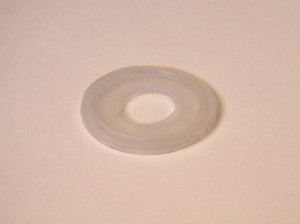One of the most popular uses for silicone rubber molding is as a gasket. Used mostly for creating a seal or a cushion between two hard surfaces, silicone rubber molded gaskets can be made to precisely fit the required dimensions. Using the liquid silicone rubber molding process, quality manufacturers can create multiple quantities to specification to make the perfect gasket.
Size
Since gaskets are typically form fit to a precise shape, the proper size is necessary to prevent leaks and friction. From air to water to oil to fuel, different gases, liquids and vapors can wreak havoc on environments when gaskets fail. The required gasket size must be matched to specifications during the fabrication process to ensure a snug fit and best functionality of the finished machine or device. Rubber molded gaskets can range in size from small screw-sized holes to surround molding for large inserts in machinery. The American National Standards Institute (ANSI) provides value guidelines for rubber sheet gaskets and other seals that includes size and density.
Thickness
The recommended thickness of a gasket typically comes from testing. Test methods and standards as recommended by ANSI rely upon many factors, including the amount of compression, heat, fire hazard risk and 
Color
In most cases, the gasket will never be seen unless there’s a problem. However, colors are always a part of product design, sometimes they need to match another part of the product. Custom pieces can be translucent, solid or even clear. When color counts, choose a silicone rubber molding manufacturer that can match hues to within one delta to ensure the perfect look.
Attachment
How a gasket will be attached to the surfaces is an important part of fabrication. Adhesives are one option, but the silicone rubber might need to be treated with a coating to improve the bonding capabilities. Proper hole alignment for parts screwed together is critical for a tight fit. Another option is to include extrusions for interlocking pieces.
Durability
A gasket’s durability is often the difference between it preventing a leak and upholding the integrity of the product. Using a material such as molded silicone rubber is typically ideal for a gasket, because it can withstand extremely high and low temperatures, provides reliable insulation and is resistant to many harsh environments.
The durometer or pliability of the material chosen for the gasket depends on the amount of closing force used in bringing together the opposing surfaces. A softer, more flexible rubber molding material is usually used with a lower closing force, like a door or drawer. A stiffer, denser rubber molding is used for harder surface contact, such as a screwed-in component or two sheets of metal. A tight seal that meets all design specifications can prevent gases and liquids from passing through.
SiTECH manufactures custom silicone rubber gaskets for a wide range of industries, including aviation, military, medical and industrial manufacturing. For an estimate on the manufacture of silicone rubber gaskets for your next product design, contact SiTECH today.









